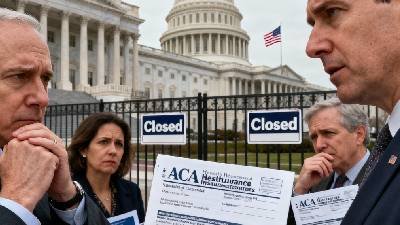The US government shutdown 2025 has stretched into its twenty-fourth day, becoming one of the longest in recent American political memory. While historical shutdowns have often revolved around budget disagreements or immigration, this year’s crisis finds its flashpoint at the heart of healthcare: the deadlock over Affordable Care Act (ACA) subsidies. For millions of Americans and thousands of federal workers, the resulting uncertainty goes far beyond politics—it’s a daily struggle for pay checks, medical coverage, and essential services.
The ACA Subsidies Standoff: What’s at Stake?
The main point of contention has been federal funding for ACA health insurance subsidies. These subsidies make coverage affordable for low- and middle-income families, and any interruption risks higher premiums or lapses in coverage for people who depend on marketplace plans. While the Senate has proposed temporary extensions, House negotiators tied subsidy reforms to other spending priorities—stalling progress and turning healthcare into a bargaining chip [ACA subsidies standoff news].
At the centre is a stand-off between two philosophies: one side insists the subsidies are vital in maintaining accessible healthcare and preventing mass disruptions in coverage during the open enrolment period, while the other side pushes for cost controls, eligibility overhauls, or stricter fraud checks before any extension can be funded.
Who’s Feeling the Shutdown’s Impact Most?
1. Federal Workers and Contractors
Over 800,000 federal workers have seen pay checks delayed or halted, with “excepted” staff required to work without immediate compensation. Government contractors, from janitorial staff to defence analysts, are also suffering as projects are paused and vendors stand unpaid. The US shutdown impact on federal workers is visible in everything from empty offices to lines at food banks in Washington, D.C. and beyond.
2. Americans Relying on ACA Plans
The subsidy standoff has left millions in limbo. Families who count on subsidized ACA plans to cover chronic conditions, maternity care, or urgent surgeries are wondering if their policies will lapse—or if they’ll be stuck with unaffordable premiums. This fear is especially pronounced for middle-income earners who don’t qualify for Medicaid but depend on federal assistance to make healthcare bills manageable.
3. Small Businesses and State Agencies
Many small businesses use ACA exchange plans for their employees. Uncertainty over subsidies affects not just workers, but business owners who fear a spike in costs or a scramble to find alternative coverage. State health agencies, meanwhile, have been forced to freeze or reconfigure outreach programs for enrolment and preventive care.
Disrupted Services and Daily Life
Throughout Washington and across remote federal locations, crucial services are being delayed or mothballed:
- Social Security and Medicare: Although checks continue to be sent, support hotlines are overloaded and applications for new benefits are delayed.
- National Parks: Staff shortages have led to closures, vandalism, and compromised safety.
- Tax Refunds, Passport and Visa Processing: IRS employees are furloughed, causing major backlogs in routine processing.
Healthcare, however, remains the most immediate pain point for many families, with news outlets reporting stories of cancelled surgeries, delayed prescriptions, and hospitals unsure if insurance claims will be honoured.
Washington’s Political Chessboard: What Could Reopen the Government?
With mounting pressure, several avenues could lead to an end to the shutdown:
A. Temporary “Clean” Funding Bill
Some moderate lawmakers are pushing for a short-term funding bill that keeps all agencies open—and ACA subsidies flowing—while negotiations continue separately on longer-term healthcare reforms. If passed, this could provide instant relief but only temporarily kick the can down the road.
B. Grand Healthcare-Infrastructure Bargain
Rumors circulate of a bigger deal combining ACA subsidies with infrastructure spending, enticing both sides to compromise. Business groups, unions, and some governors have voiced support, highlighting the economic risk if both healthcare and public works remain frozen.
C. Executive Action and Backdoor Solutions
There’s speculation about administrative workarounds, such as re-routing existing health agency funds to cover the ACA gap or using waivers under public health emergency rules. While legally controversial, emergency actions might force Congress’s hand.
Economic Outlook: Ripple Effect and Recovery
Every additional day of the shutdown hits disposable income, consumer confidence, and regional economies surrounding federal hubs. The longer ACA coverage remains uncertain, the greater the risk of uninsured hospital visits, medical bankruptcies, and rising uncompensated care costs for providers.
Analysts predict Q4 GDP will dip sharply if the shutdown surpasses a month, while long-term effects could linger in healthcare markets and federal recruitment.
What Americans Can Do Right Now
- Federal workers: Use official shutdown resources, apply for unemployment if eligible, and seek local assistance for essentials.
- ACA plan holders: Contact insurers for updates and keep documentation ready for any subsidy changes.
- Business owners: Stay in contact with HR consultants and explore bridge coverage options if group plans are affected.
Final Thoughts: Navigating the Uncertainty
As the stalemate continues, millions stand on the brink—hoping leaders in Washington can put vital priorities above politics. The ACA subsidies debate is more than a budget fight; it’s about real families, real coverage, and real consequences for America’s most vulnerable citizens. Restoring the government and resolving the ACA standoff is the only way to lift this cloud hanging over workers, families, and communities. With the endgame uncertain, public pressure, citizen activism, and clear communication will be key to reopening Washington and restoring public trust.


